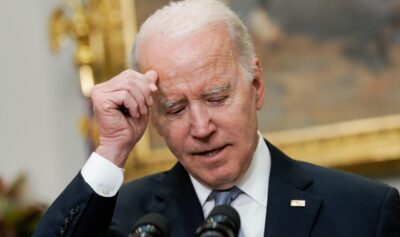
Ukraine’s fate is in Biden’s hands. Will he once again make the wrong choice?
Nexstar Media – The Hill – WHIA
Ukraine needs a game-changer. In reality, it needs two. The first is Washington’s unequivocal greenlight to use U.S. made weapons to kinetically interdict Russian troops staging along its borders — especially those near the Kharkiv Oblast.
Kyiv also needs a no-fly zone, and fast.
President Biden needs to summon his inner Franklin Roosevelt. During some of the darkest days of World War II, FDR in 1941 did something Biden thus far has been reluctant to do in Ukraine: he risked escalating war in the North Atlantic. He did so five months before Pearl Harbor.
German U-boats were pummeling British shipping. Britain’s military was facing one setback after another in the Mediterranean and North Africa at the hands of Field Marshal Erwin Rommel and his famed Afrika Korps.
Britain was at risk of being starved of food, weapons, natural resources and vital manufacturing components as commercial tonnage sunk by U-boats alarmingly increased. Roosevelt recognized that lend-lease would not be enough. British Prime Minister Winston Churchill and his generals needed a lifeline.
In May 1940, fearing that Adolf Hitler might seize the strategic mid-Atlantic island, England occupied Iceland in an operation codenamed Operation Fork. By the summer of 1941, Britain’s army and navy were stretched too thin to continue occupying and defending the country — and securing the key North Atlantic trade routes connecting the United Kingdom to U.S. ports across the eastern seaboard.
So FDR ordered U.S. forces to occupy Iceland. By August, the U.S. Navy had begun operating PBY Catalinas and PBN Mariners to patrol and protect shipping lanes from U-boats.
Roosevelt, in doing this, had Churchill’s back. England could thus focus on the fight in front of them and on preventing Nazi Germany from winning.
Now it is time for Biden to do the same for Ukrainian President Volodymyr Zelensky and his generals in Ukraine. Kyiv needs to focus its efforts on the fight in front of them in the Donbas and ultimately in retaking the Crimean Peninsula — the decisive terrain of this war.
But Zelensky cannot do that while his civilian population centers, energy infrastructure and arms manufacturing capacity continue to come under nearly daily Russian drone and missile attacks. Protecting these rear areas forces Kyiv to withhold valuable air defense systems from the frontlines and drains missile supplies. A no-fly zone over western Ukraine would free up Ukrainian military resources to take the fight to Putin.
Ample justification already exists to establish a no-fly zone. For example, Russian cruise missiles have several times overflown NATO countries on their way to targets in Ukraine, violating Polish, Romanian and Moldovan airspace.
Putin also continues to intentionally target and kill Ukrainian civilians. Recent Russian strikes in Odesa using cluster munitions provide proof enough of Putin’s war crimes and crimes against humanity, as do his increasing strikes against Kharkiv.
Iran’s recent attack on Israel is dispositive of why a no-fly zone is essential. Despite Tehran’s bravado and its use of the very same Shahed drones and cruise missiles Russia is using in Ukraine, Iran’s attack was 99.99 percent ineffectual due to the combined air defenses of Israel, the U.S., the U.K. and unnamed Arab states.
Israeli civilians deserved protection from Iran. So too do Ukrainian civilians from Russian aerial attacks.
It is past time for Biden and NATO to draw and enforce this redline.
Early on in Putin’s war, there were fears that any imposition of a no-fly zone would lead to a direct military confrontation between NATO and Russia, and potentially to full-scale war. However, as evidenced in Israel and over the skies of Syria during Iran’s attack on April 13, Washington and Moscow were able to avoid one another. They have done so for most of Syria’s civil war, which sees U.S. and Russian military forces acting in close proximity on a daily basis.
Putin likely does not want to take on NATO. As it is, the Kremlin’s air and sea forces cannot effectively engage Ukraine. They cannot control the skies over Ukraine, nor can they operate with impunity in the Black Sea. The last thing Moscow needs now is to confront NATO air and defensive assets.
Implementing a no-fly zone in western Ukraine will not likely lead to World War II-like dogfights or NATO or U.S. aircraft downing of Russian bombers. Rather, it will help deter Russian drone and cruise missile attacks and diminish their effectiveness as witnessed over the skies of Israel, Jordan, Syria and Iraq last month.
The opportunity for this strategic gamechanger is here for the taking. Biden once again finds himself at an inflection point. Biden once advised Obama not to conduct the raid that ultimately killed Osama Bin Laden. Now, he faces a similar critical decision. Will he become the man who would have let Bin Laden escape, and then let Ukraine fall? Or is he willing to fill Roosevelt’s shoes and stand on the right side of history — and on the right side of humanity?
FDR’s decision to occupy Iceland in 1941 later proved invaluable in March 1943, when large U-boat Wolfpacks again began sinking large amounts of allied commercial tonnage. The Allies were able to defeat the Germans’ surge, and never again during the remainder of the war did Hitler’s U-boats threaten allied shipping at a strategic level.
Ukraine’s survival likely depends upon Biden’s willingness to stand up against Russian aggression by ordering a no-fly zone in western Ukraine. Putin, symbolically speaking, is in Biden’s crosshairs now, just as Bin Laden was in 2011.
Biden’s recommendation to Obama proved wrong. Will he fail this test too? Ukrainian civilians literally are dying for him to make the right decision.
Mark Toth writes on national security and foreign policy. Col. (Ret.) Jonathan Sweet served 30 years as a military intelligence officer and led the U.S. European Command Intelligence Engagement Division from 2012 to 2014.
